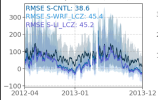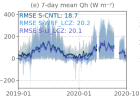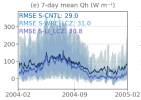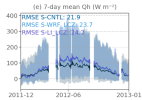Hi all,
I attempt to verify urban modelling performance by comparing single-point model outputs with observation. I compare the FSH_U from CLMU (light line) with Qh from heat flux towers (dark line).
However, the model underestimates sensible heat flux in winter in several sites and overestimates sensible heat flux in summer in other sites. I tried to understand the cause of seasonal variations in modelling sensible heat.
Is it correct to compare directly FSH_U to Qh, or Shall I use the sum of FSH_U + URBAN_HEAT + WASTEHEAT when comparing with observed Qh, though the current gap between modelled sensible heat and observation from my simulation is far larger than sensible heat from the building?
Will urban heating and air conditioning be a potential cause of sensible heat flux uncertainties? For example, if I set a small T_BUILD_MIN, will it lead to less FSH_U and URBAN_HEAT in winter? If I set a larger T_BUILD_MAX, will it lead to more FSH_U in summer?
I attached the results from several sites. Thanks for any comments.
Best,
Yuan
I attempt to verify urban modelling performance by comparing single-point model outputs with observation. I compare the FSH_U from CLMU (light line) with Qh from heat flux towers (dark line).
However, the model underestimates sensible heat flux in winter in several sites and overestimates sensible heat flux in summer in other sites. I tried to understand the cause of seasonal variations in modelling sensible heat.
Is it correct to compare directly FSH_U to Qh, or Shall I use the sum of FSH_U + URBAN_HEAT + WASTEHEAT when comparing with observed Qh, though the current gap between modelled sensible heat and observation from my simulation is far larger than sensible heat from the building?
Will urban heating and air conditioning be a potential cause of sensible heat flux uncertainties? For example, if I set a small T_BUILD_MIN, will it lead to less FSH_U and URBAN_HEAT in winter? If I set a larger T_BUILD_MAX, will it lead to more FSH_U in summer?
I attached the results from several sites. Thanks for any comments.
Best,
Yuan




